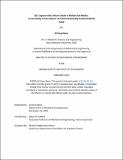CO₂ Capture with Lithium Oxide in Molten Salt Media : A Case Study of CO₂ Capture via Electrochemically Produced Metal Oxide
Author(s)
Byun, Gi Hyun
DownloadThesis PDF (2.659Mb)
Advisor
Gallant, Betar M.
Terms of use
Metadata
Show full item recordAbstract
As the unprecedented temperature rise originating from anthropogenic carbon dioxide (CO₂) emission intensifies, the development of post-combustion carbon capture technologies has been urged. Although its maturity, conventional thermal swing processes using aqueous amines, suffer from significant limitations, including high energy requirements and sorbent degradation. Electrochemical CO₂ capture technologies, which use electrical energy instead of thermal energy, have emerged as an energy efficient way to capture CO₂. This shift not only improves energy efficiency but also reduces reliance on fossil fuels, further contributing to reduction in CO₂ emissions. This work explored the potential of electrochemical metal oxide formation for CO₂ capture, a promising alternative to amine-based systems due to its exceptional sorbent (i.e., metal oxide) stability. Li₂O in eutectic mixture of potassium nitrate (KNO₃) and lithium nitrate (LiNO₃) was chosen as a case study due to the relatively well-understood chemistry of the system and the potential synergistic effects between metal oxide and the molten salt. Primarily, we investigated the synergistic effect of Li₂O in nitrate molten salt via thermal gravimetric analysis. Next, electrochemically produced Li₂O by reduction of oxygen gas was tested as a CO₂ sorbent while investigating parameters affecting its conversion to lithium carbonate (Li₂CO₃). Through this study, we suggested dissolution model as a crucial pathway for conversion. Lastly, we explored the effect of adding nitrite ion (NO₂⁻) to the molten salt. Irreversible side reaction between NO₂⁻ and CO₂ was confirmed with X-ray diffraction and NOₓ measurement. This thesis demonstrates the feasibility of electrochemical metal oxide-based CO₂ capture, highlighting some considerations in the capture step.
Date issued
2025-02Department
Massachusetts Institute of Technology. Department of Mechanical EngineeringPublisher
Massachusetts Institute of Technology